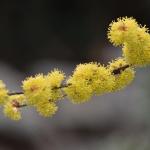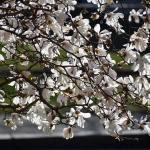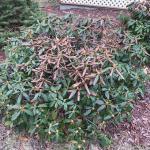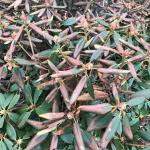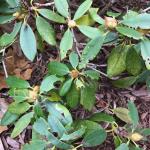UMass Extension's Landscape Message is an educational newsletter intended to inform and guide Massachusetts Green Industry professionals in the management of our collective landscape. Detailed reports from scouts and Extension specialists on growing conditions, pest activity, and cultural practices for the management of woody ornamentals, trees, and turf are regular features. The following issue has been updated to provide timely management information and the latest regional news and environmental data.
To read individual sections of the message, click on the section headings below to expand the content:
Scouting Information by Region
Environmental Data
The following data was collected on or about April 17, 2019. Total accumulated growing degree days (GDD) represent the heating units above a 50° F baseline temperature collected via our instruments for the 2019 calendar year. This information is intended for use as a guide for monitoring the developmental stages of pests in your location and planning management strategies accordingly.
|
MA Region/Location |
GDD |
Soil Temp |
Precipitation |
Time/Date of Readings |
||
|
1-Week Gain |
2019 Total |
Sun |
Shade |
|||
|
CAPE |
18.5 |
20.0 |
55 |
47 |
0.98 |
12:00 PM 4/17 |
|
SOUTHEAST |
22 |
28.0 |
53 |
47 |
0.99 |
1:00 PM 4/17 |
|
NORTH SHORE |
26 |
35.5 |
53 |
44 |
1.16 |
12:00 PM 4/17 |
|
EAST |
30.5 |
45.5 |
57 |
50 |
1.38 |
3:30 PM 4/17 |
|
METRO |
27 |
36.0 |
51 |
45 |
1.85 |
4:30 PM 4/17 |
|
CENTRAL |
28 |
35.5 |
49 |
40 |
1.94 |
3:00 PM 4/17 |
|
PIONEER VALLEY |
26 |
34.5 |
49 |
47 |
1.41 |
11:00 AM 4/17 |
|
BERKSHIRES |
22 |
31.0 |
48 |
43 |
1.75 |
10:00 AM 4/17 |
|
AVERAGE |
25 |
33.0 |
52 |
45 |
1.43 |
- |
|
n/a = information not available |
||||||
Phenology
| Indicator Plants - Stages of Flowering (BEGIN, BEGIN/FULL, FULL, FULL/END, END) | ||||||||
|---|---|---|---|---|---|---|---|---|
| PLANT NAME (Botanic/ Common) | CAPE | S.E. | N.S. | EAST | METRO W. | CENT. | P.V. | BERK. |
|
Rhododendron 'P. J. M.' |
* |
Begin |
* |
Begin |
* |
* |
Begin |
* |
|
Prunus serrulata (Japanese flowering cherry) |
* |
Begin |
* |
Begin |
* |
* |
Begin |
* |
|
Magnolia stellata (star Magnolia) |
Begin/Full |
Begin/Full |
Full |
Full |
Begin |
Begin |
Begin/Full |
Begin |
|
Forsythia x intermedia (border Forsythia) |
Full |
Full |
Full |
Full |
Begin |
Begin |
Begin/Full |
Begin |
|
Rhododendron mucronulatum (Korean Rhododendron) |
* |
Begin |
* |
Full |
Begin |
* |
Begin |
* |
|
Pieris japonica (Japanese Pieris) |
Full/End |
Full |
* |
Full |
Full |
Full |
Full |
* |
|
Cornus mas (Cornelian cherry dogwood) |
Full/End |
Full/End |
* |
Full/End |
Full/End |
Full |
Full |
Full |
|
Acer rubrum (red maple) |
Full |
Full |
* |
Full |
Full/End |
Full/End |
Full |
Full |
|
Acer saccharinum (silver maple) |
End |
Full/End |
* |
Full/End |
Full/End |
Full/End |
Full/End |
Full |
| * = no activity to report/information not available | ||||||||
Regional Notes
Cape Cod Region (Barnstable)
General Conditions: Finally, we have some GDD accumulation. The weather over the past week was mild with precipitation over the weekend. Lawns have greened up significantly in the past week. The average temperature was 49.5˚F with a high of 68˚F on April 14 and a low of 33˚F on April 11.
Pests/Problems: Winter moth larvae were observed in apple buds in the upper Cape region this past week. In general, winter moth populations are expected not to be significant enough to warrant treatment in most areas of the Cape. They should be monitored in fruit bearing apple and blueberry crops. Lecanium scale on oak - which was widespread on the Cape last year causing a lot of sooty mold in some locations - is still abundant. The nymphs overwinter on the twigs of susceptible hosts (which are numerous), but the biggest populations are mainly on oak. There are numerous parasites that often control populations; however, treatment maybe warranted in areas with large populations. Standard treatment is dormant oil applied between 35-145 GDD. Other pests observed over the last week include black knot on Prunus, juniper webworm on juniper, and azalea lacebug damage. Weeds in bloom include bittercress (Cardamine hirsuta), whitlow grass (Draba verna), mouse-ear cress (Arabidopsis thaliana), lesser celandine (Ficaria verna), and a couple of dandelions (Taraxacum officinale). Rabbits are abundant. Black legged ticks are active.
Southeast Region (New Bedford)
General Conditions: This past week’s warmer temperatures brought a stronger sense of spring to the Southeast Region. Day temperatures have been consistently in the high 50’s and 60’s with night temperatures in the 30’s and 40’s. This past weekend’s warmer days, coupled with an inch of rain, brought about bud break in many species, with many trees and shrubs leafing out. The high winds continue and we are seeing lots of blow downs and dead wood in the landscape. Soils are workable in most areas. Magnolia spp. and Forsythia spp. in full sun have bloomed this week. Early daffodils bloomed, while tulips are now in bud.
Pests/Problems: Pest and disease activity continues to be low, but with these warmer temperatures, we will need to keep an eye out for tent caterpillars and winter moths. Ticks are active. [The following photos credited to Rose Grant, volunteer at The Trustees' Haskell Public Gardens.]
North Shore (Beverly)
No conditions report this week.
East Region (Boston)
General Conditions: The cool damp spring continued intermittently throughout the week. We received rain on 6 of the 7 days, accumulating 1.38 inches, 0.92 inches of which fell on the 15th. Low temperatures over the last week ranged from 32˚F to 54˚F, averaging 41.8˚F. High temperatures ranged from 45˚F to 74˚F, averaging 60˚F. We accumulated 30.5 GDDs over four days from April 13 to 16, for a total of 45.5 so far this year. Wednesday the 17th finally felt like spring. The grass is greening up. Forsythia spp., Magnolia spp. and cherries are in bloom. Daffodils, grape Hyacinth (Muscari spp.) and Siberian squill (Scilla siberica) are in full bloom. Also in bloom are Corylopsis glabrescens (fragrant winter hazel), Rhododendron mucronulatum (Korean Rhododendron), R. mucronulatum ‘Cornell pink’ and R. praevernum (February Rhododendron). Pyrus calleryana (Bradford pear) is just beginning to open.
Pests/Problems: Garlic mustard (Alliaria petiolata) is abundant in rosettes and seedlings. Many boxwood (Buxus spp.) that had been putting on tender new growth appear to be suffering from some cold evening temperatures.
Metro West (Acton)
General Conditions: It sure feels like spring with the cool, warm, windy and rainy weather that we have been experiencing. Additionally, there was some fierce thunder and lightning on the morning of the 15th and wind gusts recorded up to 24 mph. So far, precipitation has been recorded for this area on ten of the sixteen days this month, bringing our total rainfall for this April to 2.96”. To put that number into perspective, the average rainfall total for the month of April is 4.16”. Lawns are greening up and growing especially well with this rain; leaves and flower buds are expanding; and day length is increasing by 2 or so minutes daily and will be at 13 hours and 32 minutes come April 20th. As the proverb says, “April showers, bring May flowers”. Observed in some stage of bloom this past week were the following woody plants: Acer rubrum (red maple), A. saccharinum (silver maple), Cornus mas (Cornelian cherry dogwood), C. officinalis (Japanese Cornelian cherry), Forsythia spp. (Forsythia), Hamamelis × intermedia cultivars (witch hazel), Magnolia stellata (star Magnolia), M. x loebneri 'Merrill', Pieris japonica (Japanese Pieris), Prunus spp. (cherry), and Rhododendron mucronulatum. The following were bulbs and herbaceous plants observed in bloom: Adonis amurensis (Adonis), Chionodoxa luciliae (glory-of-the-snow), Crocus spp. (Crocus), Helleborus niger (Christmas rose), Hyacinthus spp. (Hyacinth), Narcissus spp. (daffodil), Pachysandra procumbens (Allegheny spurge), Petasites japonicus (Japanese butterbur), Pulmonaria longifolia (lungwort), P. rubra (salmon-colored lungwort), Puschkinia libanotica (striped squill), Sanguinaria canadensis (bloodroot), Scilla siberica (Siberian squill), Symplocarpus foetidus (skunk cabbage), Tulipa spp. (tulip), Vinca minor (periwinkle) and Viola spp. (violet). Landscape crews are out in full force completing spring and winter storm clean ups, planting pansies and spreading mulch.
Pests/Problems: With the recent heavy rain event on Monday the 15th, there has been some erosion and soils are well saturated. Rainwater has not drained completely and puddles remain in low-lying areas. Ticks are active so continue to monitor yourself and others for these parasites. Wear light color clothes to make the job easier on you. Also seen flourishing everywhere is the basal foliage of Alliaria petiolata (garlic mustard). Other weeds seen in bloom but without the invasive tendency of the previous one mentioned are: Draba verna (spring whitlow grass), Lamium purpureum (purple deadnettle), Stellaria media (common chickweed), and Taraxacum officinale (dandelion).
Central Region (Boylston)
General Conditions: Spring really popped this week thanks to warmer temperatures and lots of sun. Spring bulbs, including some early tulips, are in full swing. Scilla siberica (Siberian squill) and Scilla luciliae (glory-of-the-snow) are both still holding strong. Many daffodils (Narcissus spp.) opened this past week, as did Tulipa ‘Mary Ann’ and Muscari armeniacum (grape Hyacinth). Magnolia x loebneri ‘Merrill’ (Loebner Magnolia), Magnolia salicifolia (anise Magnolia), and Cornus mas (Cornelian cherry) are all at peak bloom this week after several warm days. Abeliophyllum distichum (white Forsythia), Forsythia x intermedia, and Corylopsis spicata (winter hazel) all have opened recently. In wetland areas, Veratrum viride (false hellebore) quickly sprouted up over the past week.
Pests/Problems: No significant new pest issues to report this week, although ticks are certainly active.
Pioneer Valley Region (Amherst)
General Conditions: The Jekyll and Hyde weather of spring continued in the Pioneer Valley over this past reporting period. We saw cool temperatures in the 50s and lower 60s with scattered rain followed by full sun and highs that soared into the middle and upper 70s on the weekend of 4/13 and 4/14. It marked the second consecutive weekend of fantastic weather, but it appears that trend will not continue. Immediately following the warm weekend, a cold front with strong winds invaded the valley. Sustained winds from 25–35 mph and gusts over 40 mph were recorded at Barnes Airport in Westfield. According to the Northeast Regional Climate Center, the first half of April was slightly cooler than average with above-average precipitation in the tri-county region. We experienced our first thunderstorms of the season, during the overnight hours of 4/13–4/14 and the pre-dawn hours of 4/15. Rain was abundant over the past week with well over an inch of new accumulation at several weather stations. As a result, the Connecticut River reached minor flood stage at both the Northampton (113’) and Montague (28’) monitoring stations. Soils remain wet but this is a great time for transplanting, while soil temperatures are still cool and plants are just breaking dormancy. On the UMass campus, nearly every tree and shrub has swollen or broken buds at this time. Cornelian cherry dogwood, Forsythia and Magnolias are providing most of the color with cherries close behind. Red maples and elms are also providing a striking, if subtle, addition to the spring color on the landscape. Turfgrasses continue to become greener every day and mowing has commenced on campus in some areas. Soil temperatures are still below 50°F, meaning crabgrass seed won’t be germinating yet. Mosquitoes have emerged due to the warm weather over the weekend but black fly season hasn’t started yet. Spring peepers and wood frogs continue their chorus.
Pests/Problems: Winter burn on evergreen shrubs continues to be a major concern at this time. Injury on other landscape evergreens (e.g. Hinoki falsecypress) is also becoming evident, in the form of browning and desiccated needles. If the buds and shoots are clearly dead, prune out these plant parts now to avoid secondary colonization by opportunistic pests and pathogens later. If buds appear viable, wait for new growth to flush to determine if pruning will focus just on dead leaves or entire branches. Apple scab will soon be initiating the first infections of the season on emerging leaves. Most commercial crabapple cultivars found at nurseries have good to excellent resistance against apple scab. Continue scouting for white pine weevil on young, open-grown white pine and Norway spruce. While trees are not killed by this pest, they can be badly disfigured if the terminal leader is killed. Start thinking about treatment of eastern hemlock and true firs for the elongate hemlock scale, if this destructive pest is present. Scout the underside of needles on the lowest canopy branches to determine if the scale is present. Insecticide applications should occur once new growth has flushed. As new leaves start to emerge on deciduous hardwoods, we need to focus on controlling early instar gypsy moth feeding. For organic control, applications of Bt can be very effective against early instar caterpillars. For young trees and shrubs where ballooning caterpillars will be establishing in the canopy,regular scouting must be performed to detect their presence. Eastern Hampshire and Hampden Counties have been hit hard by gypsy moth feeding in recent years (https://www.mass.gov/guides/gypsy-moth-in-massachusetts#current-conditions) and the expectation is that feeding pressure will continue to push west in these counties and north into eastern Franklin County. Gypsy moth incidence has been limited in areas west of the Connecticut River to date, so it will be interesting to see if that trend changes in 2019.
Berkshire Region (Great Barrington)
General Conditions: After the long stretch of normal temperatures, the weekend starting April 13th brought a dramatic increase in temperature and number of growing degree days. The thermometer in central Berkshire County topped off at 74˚ F on the 13th and 70˚ on the 14th, causing the GDD to increase from 9 to 29 over that 2 day period. It currently sits at 31 GDD. The weekend was also wet with a thunderstorm on Sunday night accompanied by strong gusts of wind. The wind, as usual, brought down a few trees and branches but there were no reports of power outages. Rain levels year-to-date are now at normal. The rain and warm temperatures turned lawns from brown and spotty green to lush green. Grass is growing rapidly and mowing will begin shortly. Bud swell on many deciduous trees is visible but little leaf break, except on crabapples and a few other species, has taken place as of this morning (4/17). The rain left soils moist but they are draining quickly. The better draining soils are workable and some plowing by area farmers is occurring.
Pests/Problems: Despite the warm up and arrival of seasonal temperatures, pest pressures remain very low. Some wasps, honey bees, and mosquitoes were observed. Eastern tent caterpillars have not yet been found, but hatching should be imminent as Forsythia are beginning to bloom - a phenological indicator of ETC hatching. Larvae of boxwood leaf miners are actively feeding between the surface layers of boxwood leaves. Browsing by deer, rabbits, and woodchucks continues, but their food preference now seems to be the rapidly growing turfgrass. The deer tick population and frequency of tick bites remains high.
Regional Scouting Credits
- CAPE COD REGION - Russell Norton, Horticulture and Agriculture Educator with Cape Cod Cooperative Extension, reporting from Barnstable.
- SOUTHEAST REGION - Kristin McCullin, Horticulturist reporting from Haskell Public Gardens, New Bedford.
- NORTH SHORE REGION - Geoffrey Njue, Green Industry Specialist, UMass Extension, reporting from the Long Hill Reservation, Beverly.
- EAST REGION - Kit Ganshaw & Sue Pfeiffer, Horticulturists, reporting from the Arnold Arboretum, Jamaica Plain.
- METRO WEST REGION – Julie Coop, Forester, Massachusetts Department of Conservation & Recreation, reporting from Acton.
- CENTRAL REGION - Mark Richardson, Director of Horticulture reporting from Tower Hill Botanic Garden,Boylston.
- PIONEER VALLEY REGION - Nick Brazee, Plant Pathologist, UMass Extension Plant Diagnostic Lab, reporting from UMass Amherst.
- BERKSHIRE REGION - Ron Kujawski, Horticultural Consultant, reporting from Great Barrington.
Woody Ornamentals
Recent pests and pathogens of interest seen in the UMass Extension Plant Diagnostic Lab (https://ag.umass.edu/services/plant-diagnostics-laboratory):
Diseases
Winter burn and infestations of the black vine weevil (Otiorhynchus sulcatus) and lacebug (Stephanitis sp.) on Yakushima Rhododendron (Rhododendron yakushimanum). Three plants, approximately 10-years-old, suffering from cold injury sustained this past winter. Portions of the canopy covered with snow avoided injury, while the exposed upper canopy had browning and desiccated leaf margins. Many lower canopy leaves exhibit the characteristic half-moon-shaped notching on the leaf margins that is typical of vine weevil feeding. Treatment for this destructive pest will include soil drenching with parasitic nematodes (Heterorhabditis bacteriophora) to control the larvae and the use of burlap around the base of the plants to trap adults during the growing season.
Stem cankering of hawthorn (Crataegus sp.) caused by Thyronectria. Tree is approximately 30-years-old and resides in a landscape setting with full sun. Cankers on stems, branches and the trunk were observed but the tree appears otherwise healthy. The cankers were gall-like with rough margins. Cankering fungi like Thyronectria do not decay wood and in some cases, tree canopies appear normal despite the presence of numerous trunk and branch cankers.
Edema and secondary needle blight caused by Botrytis on yew (Taxus sp.). Sheared hedge row of yews that is experiencing a sporadic branch tip dieback in the canopies. Edema is an abiotic disorder that develops when plants are exposed to too much water. The property is irrigated with lawn sprinklers and in combination with the abundant rainfall last season, the condition developed. The gray mold pathogen, Botrytis cinerea, was abundant on the declining shoot tips but is rarely a primary pathogen on woody plants.
Stem cankering caused by the fungal pathogen Cytospora on Autumn Blaze® maple (Acer × freemanii 'Jeffersred'). This field-grown tree is two inches in diameter and was recently purchased from a nursery in the southeast United States. Black lesions on the stems were observed in the canopy, a common symptom of fungal stem and branch cankering. There are many species in genus Cytospora and the pathogen has a broad host range among conifers and hardwoods. Most often, Cytospora is found on Japanese maple in the landscape in our region while other maples are more resistant to infection.
Report by Nick Brazee, Plant Pathologist, UMass Extension Plant Diagnostic Lab, UMass Amherst.
Insects
Woody ornamental insect and non-insect arthropod pests to consider, a selected few:
- Emerald Ash Borer: (Agrilus planipennis, EAB) The Massachusetts DCR Forest Health Program has reported finding infestations in 12 new communities in 2019 of Emerald Ash Borer (EAB) in the towns of Alford, Stockbridge, Hampden, Southwick, East Longmeadow, Monson, Wales, Brimfield, Spencer, Ayer, Groton, and Townsend. For a state map showing current detections as well as New England-wide quarantine areas, go to https://www.mass.gov/guides/emerald-ash-borer-in-massachusetts. For more detailed info on the Emerald Ash Borer, including life cycle, images of damage, and management strategies, go to UMass Extension's fact sheet at https://ag.umass.edu/landscape/fact-sheets/emerald-ash-borer. To report a suspected find of this invasive insect, go to https://massnrc.org/pests/eabreport.htm.
This wood-boring beetle readily attacks ash (Fraxinus spp.) including white, green, and black ash and has also been found developing in white fringe tree (Chionanthus virginicus) and most recently, has been reported in cultivated olive (Olea europaea). Adult insects of this species will not be present at this time of year. Signs of an EAB infested tree may include (at this time) D-shaped exit holes in the bark (from adult emergence in previous years), “blonding” or lighter coloration of the ash bark from woodpecker feeding (chipping away of the bark as they search for larvae beneath), and serpentine galleries visible through splits in the bark, from larval feeding beneath. Positive identification of an EAB-infested tree may not be possible with these signs individually on their own.
- Winter Moth: (Operophtera brumata) The eggs of this insect, if they can be found, were laid by the females who emerged in November of 2018 and were active through the winter months (mainly November through December when temperatures are above freezing). Eggs are currently present in the landscape and hidden in cracks and crevices of bark or beneath lichen on host plants such as oak, maple, apple, blueberry, crabapple, etc. Eggs are tiny and green when first laid, but quickly turn a red-orange color soon after. At this time, anyone monitoring winter moth eggs will most likely see that they are orange in color. As the egg develops, it will turn a bright blue color, shortly prior to egg hatch. For more information about the life cycle and management of winter moth, please visit thisfact sheet: Winter Moth Identification and Management https://ag.umass.edu/landscape/fact-sheets/winter-moth-identification-management
Winter moth is a non-native insect that was identified in Massachusetts for the first time in 2003 following persistent reports of defoliation in eastern areas of the state such as Cape Anne and on the North Shore near Cohasset, Hingham, and Rockland on the South Shore in the late 1990’s. For more detailed information about the history of this insect pest in North America and Massachusetts, please visit this fact sheet: Winter Moth in Massachusetts: History and Biological Control https://ag.umass.edu/landscape/fact-sheets/winter-moth-in-massachusetts-history-biological-control
- Gypsy Moth:(Lymantria dispar) [ See also the link on current conditions in the Pioneer Valley Regional report, this issue.] Egg masses laid by female moths in 2018 can be seen at this time. This is the stage of the insect that overwinters. Egg masses are “fuzzy” or hairy and brownish-tan in color. Each egg mass can hold up to 500-1000 eggs. These masses may be found on host plant trunks and branches such as oak (favored), maple, birch, poplar, and many others, but are also laid on inanimate objects including the surfaces of homes, outdoor furniture, camping equipment, firewood piles, etc. This may make the accidental movement of gypsy moth egg masses possible.
Egg hatch for this insect is also not yet upon us, and occurs after winter moth egg hatch. Gypsy moth egg hatch typically occurs between 90 -100 growing degree days, using a base of 50°F and average temperatures. This is usually around the first week in May in Massachusetts, but variations in temperature may lead to early egg hatch in the last week in April. This can also coincide with serviceberry (Amelanchier) bloom. After egg hatch occurs, groups of tiny gypsy moth caterpillars may remain on their egg mass just before crawling to the canopy of their host plant, where they can disperse using a technique known as “ballooning”. Ballooning occurs when very young caterpillars spin a silken thread and catch the wind to blow onto a new host plant once the thread breaks. This method of dispersal can lead to host plants becoming defoliated that previously did not have egg masses directly on them, however egg masses may be present on nearby oaks, for example, and provide a local population of caterpillars.
Now (until before the last week in April) is a great time to scout the landscape and count the number of gypsy moth egg masses present not only on valuable landscape specimens that are hosts for this insect, but on nearby forested hosts such as oak which might provide sources of ballooning caterpillars. Egg mass counts can help us make decisions regarding whether or not to manage for this insect. Some individuals also use this opportunity to scrape egg masses into a container of soapy water, although this is time consuming and some egg masses will be missed.
- Asian Longhorned Beetle: (Anoplophora glabripennis, ALB) Look for signs of an ALB infestation which include perfectly round exit holes (about the size of a dime), shallow oval or round scars in the bark where a female has chewed an egg site, or sawdust-like frass (excrement) on the ground nearby host trees or caught in between branches. These particular signs of damage from the beetle may be more visible at this time of year, when host trees such as maples are leafless. Be advised that other, native insects may create perfectly round exit holes or sawdust-like frass which can be confused with signs of ALB activity.
The regulated area for Asian longhorned beetle is 110 miles2 encompassing Worcester, Shrewsbury, Boylston, West Boylston, and parts of Holden and Auburn. If you believe you have seen damage caused by this insect, such as exit holes or egg sites, on susceptible host trees like maple, please call the Asian Longhorned Beetle Eradication Program office in Worcester, MA at 508-852-8090 or toll free at 1-866-702-9938. Adult insects of this species will not be present at this time of year.
To report an Asian longhorned beetle find online or compare it to common insect look-alikes, visit: http://massnrc.org/pests/albreport.aspx or https://www.aphis.usda.gov/pests-diseases/alb/report
Concerned that you may have found an invasive insect or suspicious damage caused by one? Need to report a pest sighting? If so, please visit the Massachusetts Introduced Pests Outreach Project: http://massnrc.org/pests/pestreports.htm .
A note about Tick Awareness: deer ticks (Ixodes scapularis), the American dog tick (Dermacentor variabilis), and the lone star tick (Amblyomma americanum) are all found throughout Massachusetts. Each can carry their own complement of diseases. Anyone working in tick habitats (wood-line areas, forested areas, and landscaped areas with ground cover) should check themselves regularly for ticks while practicing preventative measures. Have a tick and need it tested? Visit the web page of the UMass Laboratory of Medical Zoology (www.tickdiseases.org) and click on the red Test a Tick button for more information.
Reported by Tawny Simisky, Extension Entomologist, UMass Extension Landscape, Nursery, & Urban Forestry Program
Plant of the Week

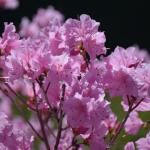 Plant of the week: Rhododendron mucronulatum; Korean Rhododendron
Plant of the week: Rhododendron mucronulatum; Korean Rhododendron
Rhododendron mucronulatum is a 4-8’ tall, deciduous rhododendron with an upright to rounded habit. Korean rhododendron has light rosy purple 1.5” diameter flowers that grow in clusters of 3-6. ‘Cornell Pink’ is a common cultivar with clear pink flowers. Flowers emerge in April and can be damaged by frost or freeze events. Leaves are medium green, 1-4” long, 0.5-1” wide, and are aromatic when crushed. Fall color is a mix of yellow, orange, and red. Rhododendron mucronulatum are best grown in an acidic, well-drained but moist soil in dappled shade. Plants should not be sited in areas with southern exposure which may lead to early bloom and increased risk of frost damage. Phytopthora root rot can be a problem in heavy, wet soils. Chlorosis can occur in high pH soils. Rhododendron can suffer from various disease and insect problems including borers and lacebugs. Plants that are sited correctly suffer from fewer problems. Korean rhododendron is a good choice for shrub borders, naturalistic areas, woodland gardens, or as a foundation plant offering early spring color.
Report by Mandy Bayer, Extension Assistant Professor of Sustainable Landscape Horticulture, UMass Stockbridge School of Agriculture
Additional Resources
To receive immediate notification when the next Landscape Message update is posted, be sure to join our e-mail list and follow us on Facebook and Twitter.
For a complete listing of upcoming events, see our Upcoming Educational Events page.
For commercial growers of greenhouse crops and flowers - Check out UMass Extension's Greenhouse Update website
For professional turf managers - Check out Turf Management Updates
For home gardeners and garden retailers - Check out home lawn and garden resources. UMass Extension also has a Twitter feed that provides timely, daily gardening tips, sunrise and sunset times to home gardeners, see https://twitter.com/UMassGardenClip
Diagnostic Services
A UMass Laboratory Diagnoses Landscape and Turf Problems - The UMass Extension Plant Diagnostic Lab is available to serve commercial landscape contractors, turf managers, arborists, nurseries and other green industry professionals. It provides woody plant and turf disease analysis, woody plant and turf insect identification, turfgrass identification, weed identification, and offers a report of pest management strategies that are research based, economically sound and environmentally appropriate for the situation. Accurate diagnosis for a turf or landscape problem can often eliminate or reduce the need for pesticide use. For sampling procedures, detailed submission instructions and a list of fees, see Plant Diagnostics Laboratory
Soil and Plant Nutrient Testing - The University of Massachusetts Soil and Plant Nutrient Testing Laboratory is located on the campus of The University of Massachusetts at Amherst. Testing services are available to all. The function of the Soil and Plant Nutrient Testing Laboratory is to provide test results and recommendations that lead to the wise and economical use of soils and soil amendments. For complete information, visit the UMass Soil and Plant Nutrient Testing Laboratory web site. Alternatively, call the lab at (413) 545-2311.
Ticks are active at this time! Remember to take appropriate precautions when working and playing outdoors, and conduct daily tick checks. UMass tests ticks for the presence of Lyme disease and other disease pathogens. Learn more

